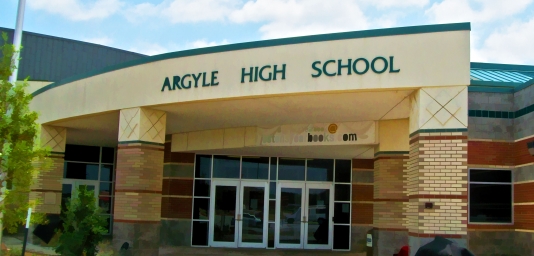We found the “needle in the haystack” that forced the insurance company to increase their payout from $483,000 to $5.2 million
Forensic abilities, expertise, & sheer bulldog persistence made all the difference in the world
A moderate hail storm blew through Argyle, Texas in (June, 2012) that caused what appeared to be minimal damage to commercial buildings in the area.
Within days, the Argyle ISD Chief of Maintenance had both his insurance adjuster and Castro Roofing out to assess the damage. The insurance company performed a cursory audit, found that a few areas of the roof had been damaged, and issued repair order with a budget of $483,000 to bring the roof back up to standard.
Volcanoes.
That’s the first thing Rudy Rodriguez, Unit Responder and leader of Castro’s Storm Hawks special storm damage assessment team, noticed when he set foot on the damaged roof. “Volcanoes” are tiny indentations in the gravel on a commercial roof that indicate impact from hail stones. The size, location, and density of volcano patterns can tell an experienced damage assessor a lot about the REAL state of a roof. And the state of this roof was a lot worse than the adjuster had discovered.
The adjuster had made two fatal flaws in his assessment; he assumed that the damage to this particular building would be comparable to the damage in other nearby buildings. His report cited a school in neighboring Prosper ISD which had sustained minimal damage—but the listed school was nearly 20 miles away. The volcanoes on this roof were telling a much different story. The other reason the adjuster give for not wanting to bother performing any material testing was because, according to him, gravel roofs rarely get damage by hail.
Rodriquez noticed that the larger volcanoes were more heavily concentrated on one particular section of the roof—apparently the hail had fallen heaviest on that spot… a common phenomenon on large roofs like schools, shopping centers, municipal buildings, and so forth.
Upon further inspection, Rodriquez discovered that the volcano markings were indeed indicative of more serious damage. He removed the gravel from the affected areas and used an old-fashioned method of detecting damage: his hands. Sensitive fingers can feel soft spots on the roof’s top coat and membrane, much like you can feel bruises on fruit.
This roof, Rodriquez concluded, had been beat up like a peach in a pinball machine.
To verify, he brought in a 600X magnification video camera to take a closer look. At that level of enlargement, tiny cracks on the surface of the membrane were clearly visible, which indicates that the cracks are actually much larger—and leak-prone—on the underside of the membrane.
To understand why, imagine touching a piece of cracked plastic with your finger. The downward pressure of your finger causes the crack to close more tightly at the top, while opening the gash wider on the underside.
This is exactly what was happening to the protective membrane of this roof—and the future result of these invisible-to-the-naked-eye cracks was easy to understand: Leaks. Lots and lots of leaks.
But not necessarily immediate leaks. Frequently in this kind of situation, those soft spots and tiny cracks don’t cause immediately obvious damage. But as the weather heats and cools and heats and cools over the next few years—and more storms blow through and pound the roof—the flaws in the protective membranes are exacerbated. The soft spots get softer; the cracks get crackier; and the roof inevitably begins to leak.

Client Success Story #152
| Client: | Argyle Independent School District |
| Project: | Storm damage to multiple buildings |
| Roof Problems | Hail damage to roof system the insurance company did not see and did not want to pay |
| Key Result | Increased settlement amount from $483,000 to $5.2 million. Insurance company was forced to pay for the BUR gravel covered roofs and metal roofs after seeing our Storm Hawks Diagnostic Report |

What’s worse, these “exacerbated soft spot” leaks are maddeningly difficult to locate and remediate. When the roof finally leaks 2 or 3 years in the future, the building owner doesn’t even connect the problem to the storm in the (now) distant past. Instead, the usual suspects for leaks—breaches around the top coat and felts and seams—are checked and caulked, and the real, underlying culprit goes undetected.
This is how “unfixable” leaks get started, and the “Repair Merry-Go-Round” begins: Repair man applies caulk to seams; roof still leaks. Call another repair man; apply more caulk; pay the bill again; roof still leaks. Almost every school district and municipality has buildings with decades-old leaks that “simply cannot be fixed.”
Nonsense.
When Castro presented its findings to the insurance company—complete with over 40 pages of photographs, technical drawings, thermal scans and evidence—they were forced to capitulate. They admitted the roof need to be replaced… but even then, they disagreed on the extent of damage and necessary budget. They argued that only the top layer of the roof membrane need to be replaced, but the underlying insulation and substrate were fine.
In reality, because of the storm damage, minor leakage had already occurred. But the initial leaking was mostly absorbed by the insulation, which kept it from seeping through into the ceiling and into the building. Castro insisted that the wet insulation and substrate materials must all be replaced as part of the job, otherwise the building would suffer even more damage in the future. Besides being a breeding ground for mold and mildew, wet insulation also rots the underlying substrate and lowers the R-value of the insulation drastically, which increases the heating and cooling costs of the building.
In the end, the insurance company agreed, after seeing the X-Vision infrared images taken by our certified infrared thermographer, to a total re-roof to Castro’s exact specifications. Not because they were strong-armed into it by Castro Roofing, but because the roof legitimately need to replaced! The final budget for the project was $5.2 million—20 times the original estimate. More importantly, Argyle ISD avoided the significant cost, aggravation, and wasted time associated with years of “merry-go-round” phantom repairs that would have inevitably ensued.
All it took was a good eye, an experienced hand, some high-tech forensic equipment, and the bulldogged persistence that is the hallmark of Castro Roofing.







